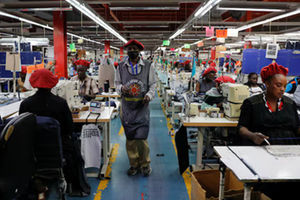Why Irrigation holds the key to food self- sufficiency

Almost half of the Sh751 billion agriculture budget is to be set aside for the development of irrigation schemes during the 2022/23 financial year
What you need to know:
- In an exclusive interview with The Citizen, National Irrigation Commission (NIRC) director general Raymond Mndolwa explains about the different strategies in place aimed at improving the country’s irrigated land size and hence increased agricultural production.
The government has allocated a record sum for irrigation initiatives in the 2022/23 financial year as it seeks to ensure that Tanzania becomes self-sufficient in food production and increases exports of both traditional and non-traditional crops, including food crops.
In an exclusive interview with The Citizen, National Irrigation Commission (NIRC) director general Raymond Mndolwa explains about the different strategies in place aimed at improving the country’s irrigated land size and hence increased agricultural production.
Following the government’s decision to revolutionise the country’s agriculture what are the NIRC strategies to achieve the intended goals?
The government is planning to increase the irrigation area from 727,280.6 hectares to 1,200,000 hectares come 2025.
To start with, NIRC will implement 25 new irrigation schemes in the 2022/23 fiscal year.
The other 30 irrigation schemes would be rehabilitated following negative impacts of floods, age and damages.
NIRC will also build 15 dams in different parts of the country.
The Commission has also sought consultancy for designing 22 irrigation projects in strategic valleys located in different parts of the country such as Mara, Rufiji and Nkomazi.
These strategic projects are being prepared alongside funds mobilisation for adequate implementations slated for the 2023/24 fiscal year.
However, there are projects that would be executed in the 2022/23 financial year through donations and loans.
For instance, Badea is expected to fund nine irrigation projects this fiscal year through the government loans, and NIRC is now at different stages of verifications.
Also, the Kuwait Fund is scheduled to fund a dam and irrigation scheme in Kigoma Region.
That is the nutshell starting from the 2022/23 fiscal year when the actual agricultural transformation has taken place through the president’s approval and massive investment in the sector through irrigation.
In total the government has committed Sh416 billion, which is equivalent to 55 percent of the Ministry of Agriculture’s budget, so as to fund the country’s irrigation projects with investment by Badea and the Kuwait Fund exclusive.
Sh316 billion out of Sh416 billion allocations, which is equivalent to 76 percent, will be used for implementation of development projects, while the remaining Sh100 billion will fund recurrent expenditures.
Currently, I have been verifying irrigation projects that will be funded by Badea and Kuwait Funds in Rukwa, Katavi, Songwe and Mbeya regions because they involve government loans.
Of all the regions, Mbeya tops others after getting 13 irrigation projects in the 2022/23 fiscal year, mostly involving rice production.
Why has NIRC irrigation projects given top priorities to rice production that attracted over Sh475 billion last year?
This is because naturally, Tanzanians perception is that irrigation in Tanzania was designated for rice production.
On the contrary, NIRC is designing irrigation projects in areas that produce other products including onions, sunflower, palm trees, avocados, etc.
This is what developed countries like China and Japan did to turn them into major rice producers.
Following the massive investment in irrigated rice farming, what are your future harvest forecasts?
Rice production will definitely double next season because farmers harvested four to six bags per acre when farming without using irrigation.
However, with irrigation infrastructure and use of better or improved seeds, yields from the same piece of land would increase to between 22 and 35 bags per acre.
Therefore, apart from making major investment in irrigation farming, the government is also directing more funds in the seeds multiplication to enable farmers get improved and accurate seeds.
Furthermore, the government is mobilising increased use of fertilizers, being the reason for investing Sh150 billion for provision of subsidised fertilizers.
The programme is scheduled to be launched by President Samia Suluhu Hassan during the Farmers Day, famous as Nanenane Day, to be held in Mbeya.
Through irrigation programmes, are there plans to increase wheat production and save the money spent on its importation?
There are private individuals who have started investing in wheat production as the government mobilises more investments.
Those owning large farms have started constructing irrigation infrastructure.
But, the government has put investment priorities in agricultural crops that will add to the country’s capacity to produce wheat and edible oil which are the key areas that seriously have negatively impacted the world during the Russia-Ukraine war.
The government has therefore started putting efforts in production of seeds to that would be supplied to farmers in the country’s efforts to increase wheat production.
In general, we may not see the changes at the early stages, because these things are taking place now, but after some times changes would be vivid through increased production and exports.
There is a general thinking that wheat could be cultivated in the same farms after rice harvests. Do you declare it as opportunity for rice farmers to benefit from both crops using the same irrigation infrastructures?
In order to make that practical, we are supposed to be sure that farmers can harvest twice in a season.
The shortage of enough rains and irrigation water makes the thinking difficult to be practised.
That has forced NIRC to comprehensively invest in water harvesting which is our responsibility to improve irrigation infrastructures and sustainability in the country.
For instance, there is ongoing talks on how to protect the Ruaha River due to the presence of the Julius Nyerere Hydropower Project (JNHPP), which is a country’s strategic project.
This is because it is our obligation and every government executive to ensure more water flows to the power generation project.
During my visit, I held talks with Mbeya Regional Commissioner (RC) Juma Homera where I asked him to look for suitable areas for construction of four to five water dams in the 2023/24 fiscal year.
The project aims at guaranteeing sustainable agricultural production while at the same time maintaining constant flow of water in Ruaha River and therefore the JNHPP.
Therefore, we will start with water harvesting for sustainable farming that would be extended to other uses for the best interest of the nation.
Failure to do so, we will come at a place where the country will be forced to choose between rice production and power generation.
Ultimately, the choice will be power generation because electricity would be used by the whole nation as compared to rice farming that could be regarded as the family issue.
To avoid that, we are supposed to prepare ourselves by creating conducive environment for farmers to continue crops cultivation despite the available challenges.





